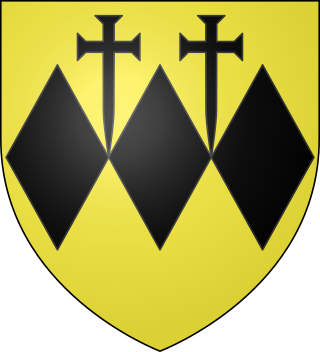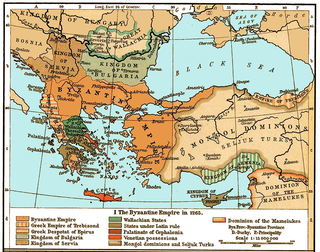Related Research Articles

Andros is the northernmost island of the Greek Cyclades archipelago, about 10 km (6 mi) southeast of Euboea, and about 3 km (2 mi) north of Tinos. It is nearly 40 km (25 mi) long, and its greatest breadth is 16 km (10 mi). It is for the most part mountainous, with many fruitful and well-watered valleys. The municipality, which includes the island Andros and several small, uninhabited islands, has an area of 380 km2 (146.719 sq mi). The largest towns are Andros (town), Gavrio, Batsi, and Ormos Korthiou.
Marco Sanudo was the creator and first Duke of the Duchy of the Archipelago, in Italian: "Duca del Mare Egeo e Re di Candia", Barone delle Isole di Nasso, Pario, Milo, Marine ed Andri, duchy granted by the Republic of Venice to him and all his descendants. After the Fourth Crusade his lineage became named Sanudo de Candia.

The Duchy of the Archipelago, also known as Duchy of Naxos or Duchy of the Aegean, was a maritime state created by Venetian interests in the Cyclades archipelago in the Aegean Sea, in the aftermath of the Fourth Crusade, centered on the islands of Naxos and Paros. It included all the Cyclades. In 1537, it became a tributary of the Ottoman Empire, and was annexed by the Ottomans in 1579; however, Christian rule survived in islands such as Sifnos and Tinos.

William of Villehardouin was the fourth prince of Achaea in Frankish Greece, from 1246 to 1278. The younger son of Prince Geoffrey I, he held the Barony of Kalamata in fief during the reign of his elder brother Geoffrey II. William ruled Achaea as regent for his brother during Geoffrey's military campaigns against the Greeks of Nicaea, who were the principal enemies of his overlord, the Latin Emperor of Constantinople Baldwin II. William succeeded his childless brother in the summer of 1246. Conflicts between Nicaea and Epirus enabled him to complete the conquest of the Morea in about three years. He captured Monemvasia and built three new fortresses, forcing two previously autonomous tribes, the Tzakones and Melingoi, into submission. He participated in the unsuccessful Egyptian crusade of Louis IX of France, who rewarded him with the right to issue currency in the style of French royal coins.

The Battle of Halmyros, known by earlier scholars as the Battle of the Cephissus or Battle of Orchomenos, was fought on 15 March 1311, between the forces of the Frankish Duchy of Athens and its vassals under Walter of Brienne against the mercenaries of the Catalan Company, resulting in a decisive victory for the mercenaries.

The War of the Euboeote Succession was fought in 1256–1258 between the Prince of Achaea, William of Villehardouin, and a broad coalition of other rulers from throughout Frankish Greece who felt threatened by William's aspirations. The war was sparked by Villehardouin's intervention in a succession dispute over the northern third of the island of Euboea, which was resisted by the local Lombard barons with the aid of the Republic of Venice. The Lord of Athens and Thebes, Guy I de la Roche, also entered the war against William, along with other barons of Central Greece. Their defeat at the Battle of Karydi in May/June 1258 effectively brought the war to an end in an Achaean victory, although a definite peace treaty was not concluded until 1262.
Angelo Sanudo was the second Duke of the Archipelago from 1227, when his father, Marco I, died, until his own death.
Marco II Sanudo was the third Duke of the Archipelago from 1262 to his death.
Florence Sanudo or Fiorenza, was Duchess of the Archipelago in 1362–1371, in co-regency with her second spouse.
Maria Sanudo was lady of the island of Andros in the Duchy of the Archipelago in 1372–1383, and lady of the island of Paros and of one third of Negroponte in 1383–1426 in co-regency with her spouse, Gaspare Sommaripa.
Guglielmazzo Sanudo, fl. between 1349 and 1362, was a Lord of Gridia.

Francesco I Crispo, Patrizio Veneto was the tenth Duke of the Archipelago through his marriage and the will of Venice.

Giacomo I Crispo was the eleventh Duke of the Archipelago, etc., from 1397 to 1418, son of the tenth Duke Francesco I Crispo and wife Fiorenza I Sanudo, Lady of Milos, and brother of John II and William II.
Pietro Zeno, was lord of Andros from 1384 until his death in 1427, and a distinguished diplomat in the service of the Republic of Venice.
George I Ghisi was a Latin feudal lord in medieval Greece.
Bartholomew II Ghisi was a Latin feudal lord in medieval Greece, lord of Tinos and Mykonos, Triarch of Negroponte and Grand Constable of the Principality of Achaea.
Marino Dandolo was a Venetian nobleman and first Latin ruler of the island of Andros following the Fourth Crusade. He was a member of the prominent Dandolo family. He accompanied Marco Sanudo on the conquest of the Aegean Islands in 1207, and was awarded the island of Andros as a sub-fief. He was expelled from his island around 1239 by Geremia Ghisi, and died in exile before August 1243.
John of Durnay was the Baron of Gritzena in the Principality of Achaea in the late 1280s and early 1290s.
Paros is an island of the Cyclades group in the central Aegean Sea, which in 1389 became a separate lordship within the Duchy of the Archipelago that lasted until the Duchy's conquest by the Ottoman Empire in 1537.
Januli I da Corogna was the first autonomous lord of the Aegean island of Sifnos.
References
- ↑ Miller 1908, pp. 580–581.
- ↑ Freely 2006, p. 136.
- 1 2 Miller 1908, p. 581.